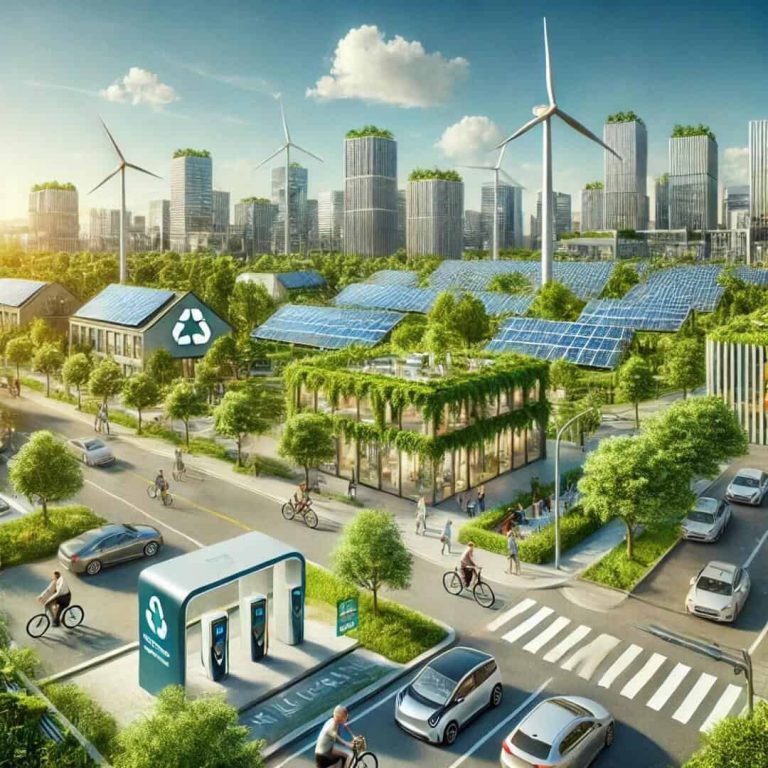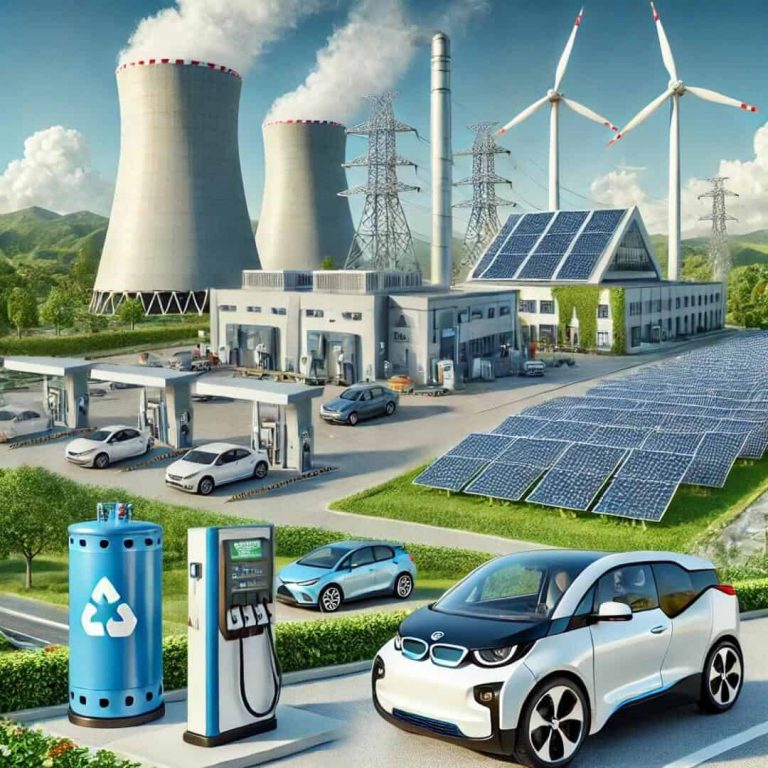What Is Green Technology? How to Become Eco-friendly Business
In today’s fast changing world, the significance of implementing sustainable practices has never been higher. Green technology, also known as sustainable technology, is at the vanguard of this movement, providing creative solutions for reducing our environmental imprint. Businesses throughout the world are rapidly understanding the need of incorporating eco-friendly practices into their operations, not just to protect the environment, but also to improve their long-term sustainability and profitability.
Companies that embrace green innovation and eco-friendly practices can help to create a more sustainable future while also appealing to an increasing number of environmentally concerned consumers. In this article, we will look at what green technology is, its benefits, and practical steps that organizations can take to become more environmentally friendly.
What Is Green Technology?

Green technology, often referred to as sustainable technology or greentech, encompasses a broad range of practices and innovations intended to lessen their negative effects on the environment and advance sustainability. It comprises developing and putting into practice products, services, and procedures that maximize the use of renewable resources, cut down on waste and pollution, and boost energy efficiency.
Fundamentally, the goal of green technology is to achieve a balance between environmental preservation and technological advancement. This entails using renewable energy sources, such as solar, wind, and geothermal energy, in addition to advancements in the transport and storage of green energy. It also covers environmentally friendly methods for transportation, manufacturing, and agriculture.
One of the most significant aspects of green technology is the emphasis on the complete lifespan of goods and processes. This includes taking into account the environmental effect of design and production, as well as disposal and recycling. Greentech recycling is a critical component that ensures resources are reused and repurposed rather than ending up in landfills.
Furthermore, green technology frequently uses cutting-edge discoveries from many sectors such as biotechnology, nanotechnology, and information technology to improve sustainability. For example, technological developments in environmental management systems provide improved monitoring and minimization of pollutants and waste.
Businesses that implement green technology can not only minimize their environmental impact, but also save money via greater energy efficiency and waste management. Furthermore, it presents companies as sustainability leaders, attracting eco- friendly customers and investors.
What Are the Benefits of Green Tech?
There are several advantages to green technology for companies, the environment, and society as a whole. Positive effects, from cost savings to enhanced brand perception and beyond, become more apparent when businesses embrace sustainable practices.
Advantages for the Environment
The main benefit of green technology is that it is environmentally friendly. Utilizing renewable energy sources like wind and solar can help businesses cut down on their dependency on fossil fuels and their carbon impact. This transition contributes to cleaner environments by lowering air and water pollution and mitigating the effects of climate change.
Savings on Costs
Businesses can save a lot of money by implementing sustainable technologies. Utility bills are reduced by energy-efficient technologies like sophisticated HVAC systems and LED lights. Furthermore, long-term savings from lower energy bills and possible tax or government benefits can be obtained by investing in green tech solar installations.
Improved Image of the Brand
Green brands are attracting more and more attention from consumers. Through the implementation of environmentally friendly technologies and exhibiting their dedication to sustainability, companies can improve their reputation and draw in a devoted market. Gaining a competitive advantage in the sector and a larger market share can result from this.
Adherence to Regulations
Environmental rules are being tightened by governments across the globe. Businesses can keep ahead of regulatory requirements and steer clear of any fines or penalties by incorporating green innovation into their operations. Adherence to environmental regulations additionally presents prospects for government grants and collaborations.
Worker Contentment
Maintaining a sustainable footprint may boost staff morale and draw in top talent. Professionals generally favor working for organizations that place a high priority on environmental responsibility. Increased job satisfaction, lower attrition, and a more driven staff are possible outcomes of this.
Future-Proofing
Businesses that make investments in green technology energy are better positioned for long-term success as the world continues to transition towards sustainability. They can withstand fluctuations in energy costs, shortages of resources, and shifting consumer tastes better.
Types of Green Technology

A wide range of inventions and methods intended to advance sustainability and lessen environmental damage are together referred to as “green technology.” Here, we look at a few of the most important types of green technology that are changing markets and opening doors to a more environmentally friendly future.
Nuclear Energy Technology
Nuclear reactions are utilized in nuclear energy technology to produce heat, which is subsequently converted to electrical power. Because it emits no greenhouse gasses when in use, this energy source is regarded as ecologically benign. Small modular reactors (SMRs), an advanced type of nuclear reactor, have better efficiency and safety characteristics. Although there are drawbacks to nuclear energy, such as managing radioactive waste, research and development in this area is concentrated on developing safer and more sustainable alternatives.
Electric Vehicles
The most important development in green technology is the growth of electric vehicles, or EVs. EVs have no tailpipe emissions since their motors are powered by electricity that is stored in batteries. By doing this, air pollution is lessened and reliance on fossil fuels is reduced. Advancements in battery technology are augmenting the endurance, efficiency, and cost-effectiveness of electric vehicles (EVs), rendering them a feasible substitute for conventional internal combustion engine automobiles.
Solar Power
Using solar power or photovoltaic (PV) panels, solar power captures energy from the sun. Because of its scalability and potential for large environmental advantages, it is one of the most popular types of green tech solar energy. Solar farms, rooftop installations, and integrations into building materials are all possible for solar power systems. Improvements in photovoltaic technology and energy storage systems are raising the efficiency and availability of solar energy for both commercial and residential applications.
Hydrogen
The use of hydrogen as a flexible and sustainable energy source is growing. It may be made in a number of ways, for example by electrolyzing water with renewable energy sources. Fuel cells that employ hydrogen as a fuel can produce just heat and water as byproducts while producing power. Because of this, it may be used as a clean energy source for a variety of tasks, including industrial and transportation activities. To the extent that hydrogen may be used as a sustainable energy source, infrastructural and technological advancements in this area are essential.
These types of green technology are just a few of the breakthroughs driving the transition to sustainability. Each plays an important role in decreasing environmental impact and encouraging the use of renewable resources.
How to Become Eco-friendly Business
Businesses who want to lessen their influence on the environment and contribute to a sustainable future must implement eco-friendly strategies. Here are some actions you might do to assist your company in going greener:
-
Evaluate the Effects You Have on the Environment
Examine your company’s processes in detail to find areas where you may cut back on emissions, energy use, and waste. This may entail assessing your office procedures, production procedures, and supply chain.
-
Put Energy-Efficient Measures in Place
Invest in energy-efficient HVAC systems, smart thermostats, and LED lights as examples of green tech energy solutions. To take advantage of renewable energy sources and lessen your dependency on fossil fuels, think about putting in advanced solar panels
-
Take Up Sustainable Habits
Include eco-friendly technologies into your day-to-day activities. This might entail recycling initiatives, water conservation measures, and the use of environmentally friendly products. Motivate staff members to embrace environmentally friendly habits, such cutting back on paper goods and taking part in green tech recycling programs.
-
Encourage Environmentally Friendly Innovation
Promote creativity inside your company to create innovative, environmentally friendly goods and services. Research and development of technological environmental solutions that lower carbon emissions and advance sustainability may fall under this category.
-
Form Eco-Friendly Collaborations
Assist vendors and suppliers who place a high priority on sustainability. Make sure that the materials in your supply chain are sourced ethically and in accordance with environmental regulations. Work together with groups that are as committed to environmental responsibility as you are.
-
Employee Education and Involvement
Encourage a sustainable culture among staff members by stressing the value of eco-friendly behavior. Give them the tools and knowledge they need to adopt eco-friendly behaviors at home and at work. Encourage their involvement in environmental activities and include them in sustainability projects.
-
Track and Report Developments
Maintain a close eye on your environmental performance and establish quantifiable targets for growth. Inform all relevant parties on your success, such as staff members, clients, and investors. Being open and honest about your sustainability initiatives will increase your reputation and draw more eco-aware customers.
-
Utilize Technology
Make the most of cutting-edge technologies to improve your environmental efforts. This might involve employing digital technologies to improve energy use and cut waste, purchasing electric cars for your fleet, and implementing green tech solar solutions.
By taking these actions, companies can lower their technology environmental effect considerably, increase the effectiveness of their operations, and win over more and more environmentally conscientious customers. Adopting eco-friendly procedures not only helps the environment but also establishes your company as a pioneer in sustainability.
Summary
In conclusion, green technology, sometimes referred to as sustainable technology, is essential for tackling environmental issues and advancing sustainability. It includes a broad spectrum of improvements meant to lessen their influence on the environment, improve energy efficiency, and encourage the use of renewable resources. Green technology offers a variety of options to satisfy the increasing demand for environmentally friendly activities, ranging from solar power and hydrogen to electric vehicles and nuclear energy technologies.
Using green technology has numerous advantages. Companies may improve their brand image, save a lot of money, and comply with more and more environmental standards. In addition, adopting green innovation can boost worker happiness and protect companies from changing consumer trends in the future.
Moreover, it is crucial to evaluate your company’s environmental effect, put energy-saving measures in place, and embrace sustainable business practices if you want to become an eco-friendly enterprise. Important actions include encouraging green innovation, forming eco-friendly alliances, and teaching staff members about sustainability. Businesses can fulfill their environmental commitments and make a positive impact on the future by utilizing cutting-edge technologies and tracking their outcomes.
Therefore, companies hoping to prosper in a world that is changing quickly need to embrace green technologies, not just follow the fad. Businesses may lessen their environmental impact, save money over the long run, and establish themselves as pioneers in the transition to sustainable practices and technologies.
